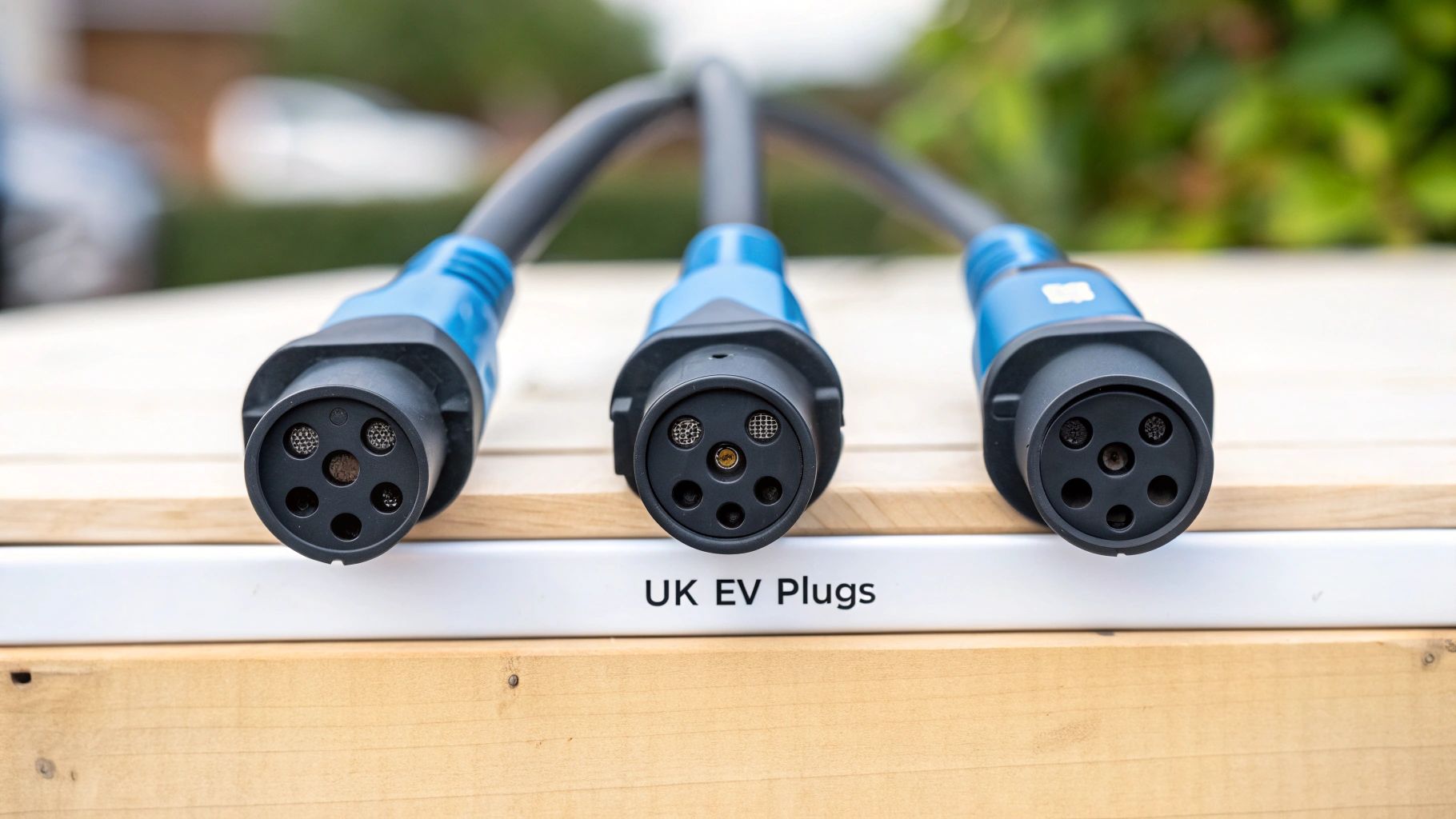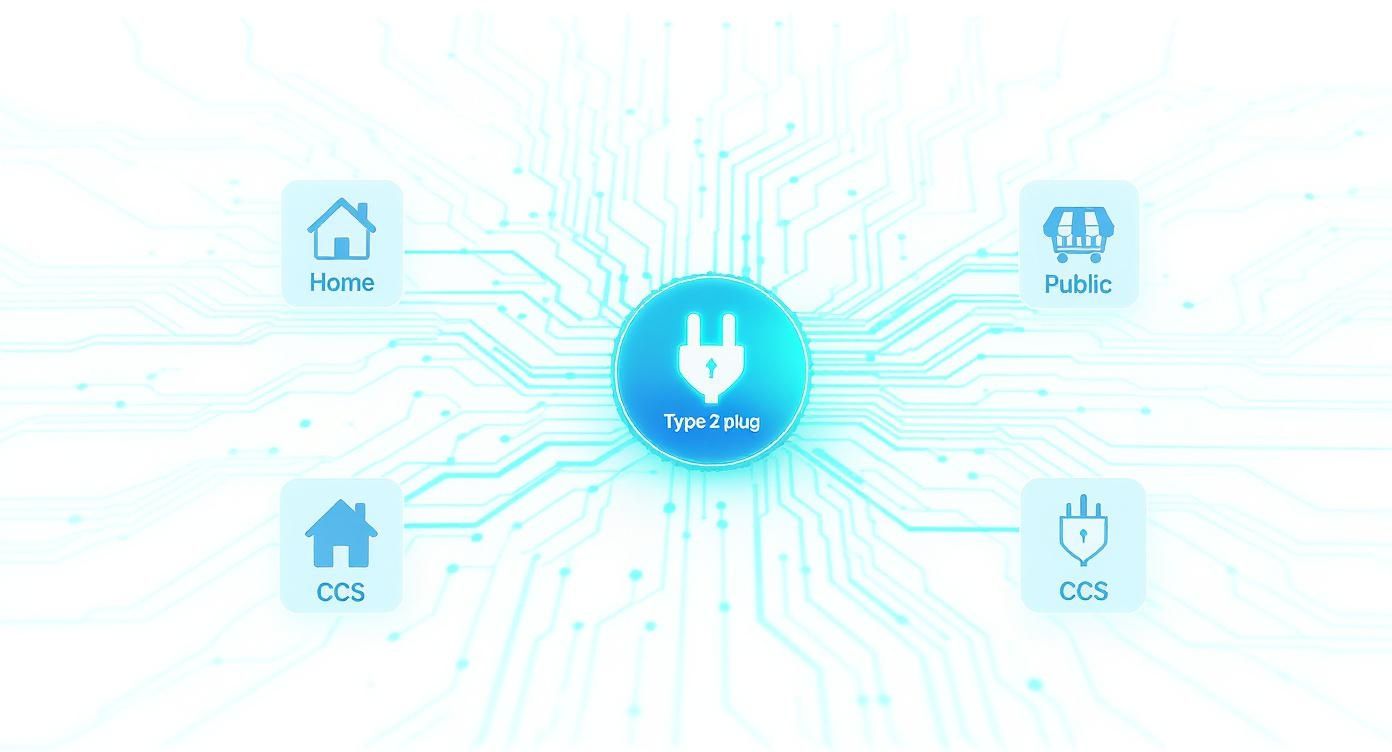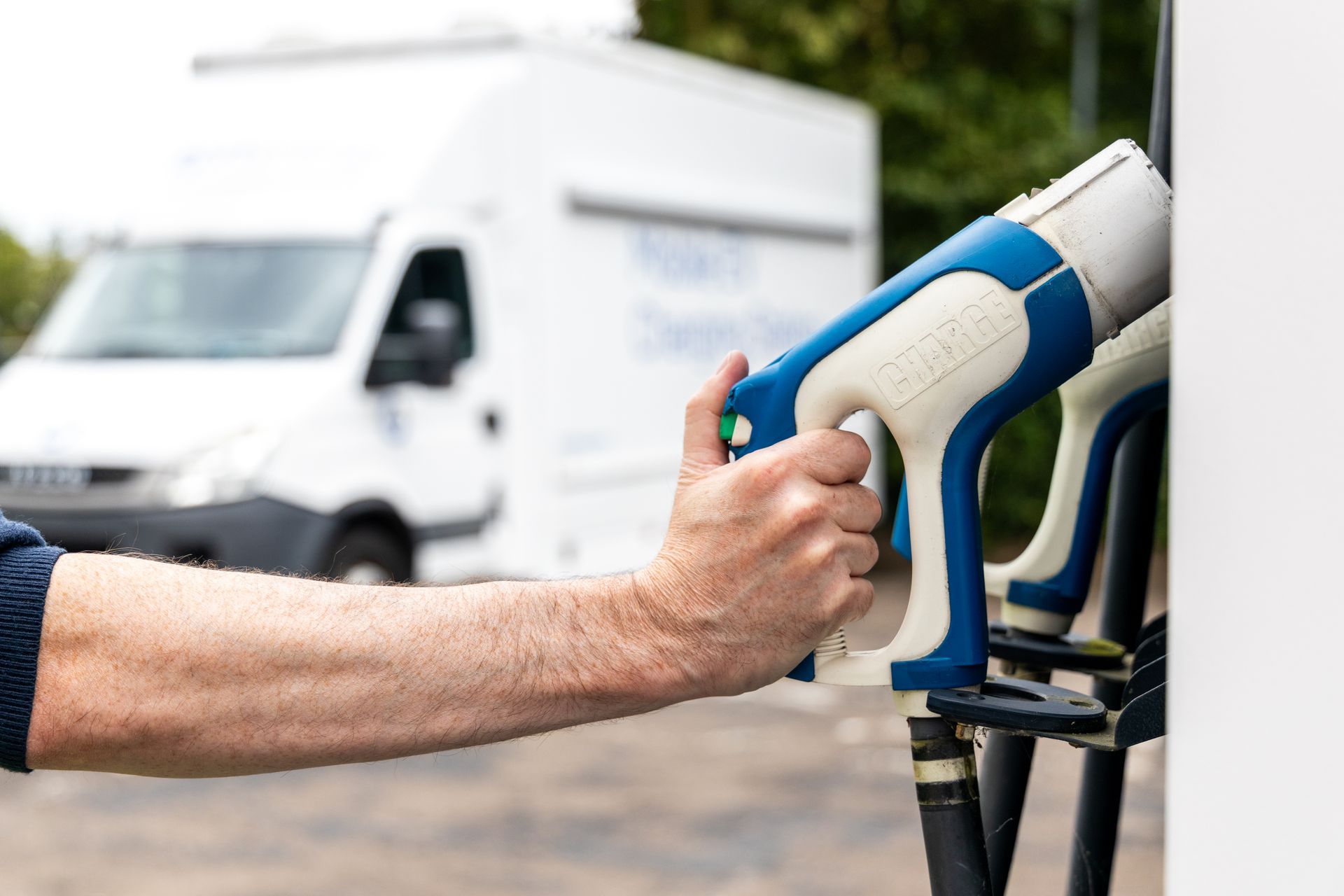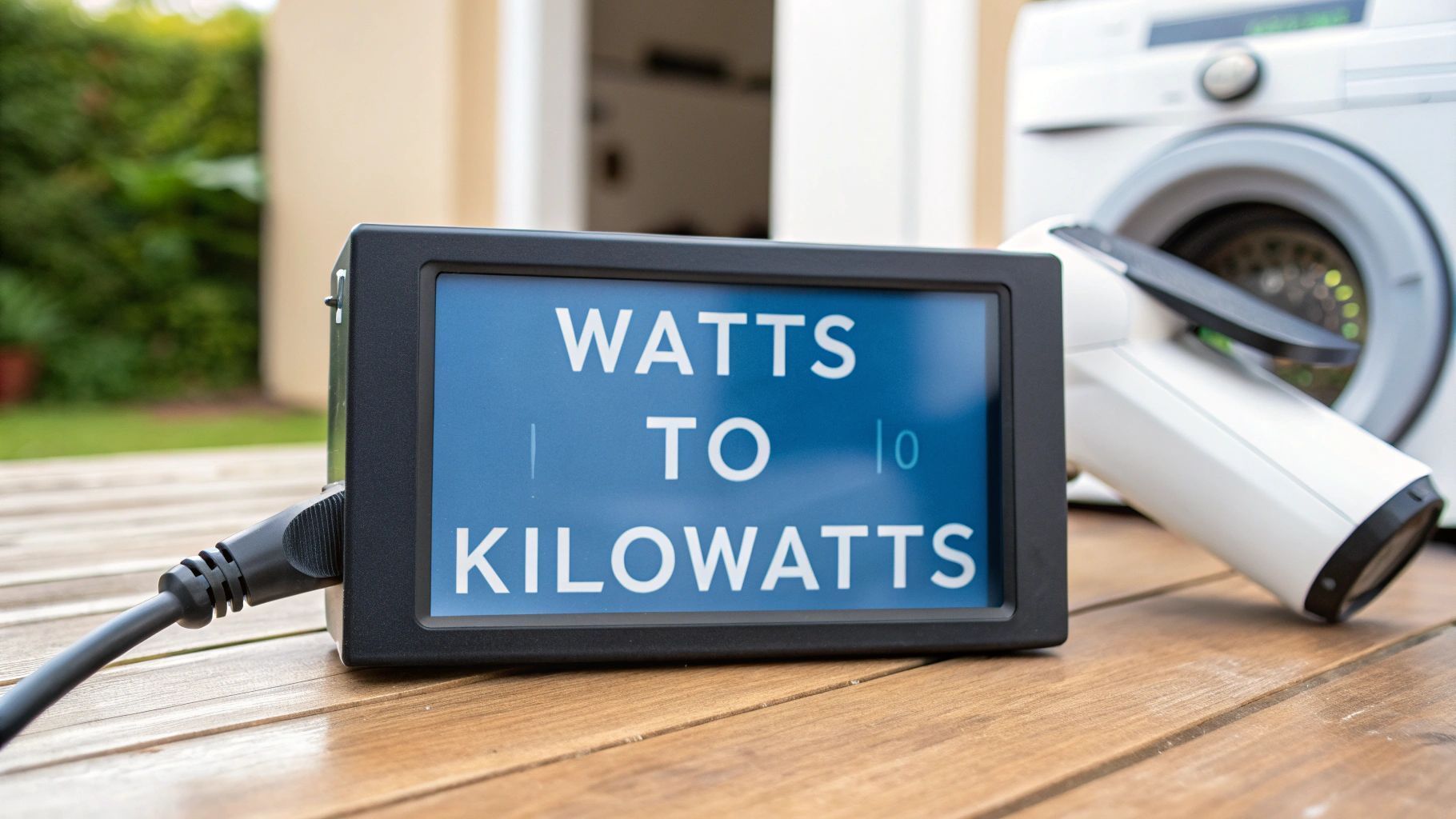UK EV Charger Connector Types Explained
Dipping your toes into the electric vehicle world can feel a bit like learning a new language, especially when you first come across all the different charging plugs. Don't worry, it's simpler than it looks. The main UK EV charger connector types you'll meet are Type 2 for everyday AC charging and CCS or CHAdeMO for the fast DC charging you'll use on the go. Getting your head around the difference is the secret to a stress-free charging life.
Navigating UK EV Charger Connector Types

Think of EV connectors like phone chargers before USB-C came along and simplified everything. There were a few key players, each built for a specific job. For electric vehicles here in the UK, it’s a similar story but far less complicated than it first seems. The whole scene is really dominated by just a handful of designs, each one shaped for a different charging speed and situation.
The big difference is between Alternating Current ( AC ) and Direct Current ( DC ) charging. AC charging is the slow-and-steady option, perfect for topping up your battery overnight at home or during a long stop at the supermarket. DC charging, on the other hand, is all about speed. It delivers a serious amount of range in a short burst, making it the go-to for motorway service stations.
The Core Connectors in Britain
To feel confident pulling up to any charge point, you only need to recognise a few key connectors. For most of your charging, you’ll be reaching for a Type 2 connector. This has become the standard for all new electric cars sold in the UK and across Europe for AC charging. Simple.
For those times you need a quick boost on a long journey, you’ll mainly find two DC connectors:
- CCS (Combined Charging System): This is the king of rapid charging in the UK. It cleverly combines the Type 2 AC connector with two extra DC pins, all in one neat plug. Most new EVs have this.
- CHAdeMO: Pioneered by Japanese manufacturers, you'll find this on slightly older models like the Nissan Leaf. While still around, it’s becoming less common as CCS takes over as the dominant force.
This standardisation shows how the UK is moving in step with the rest of Europe. The Type 2, also known as Mennekes, is the undisputed European standard for home and public AC chargers. And while you'll still see CHAdeMO chargers, the rapid growth of CCS stations signals a clear move towards a single, faster charging system for everyone.
Understanding these core differences is the first step towards mastering your EV. Knowing whether you need a slow overnight charge or a quick rapid top-up determines which type of connector you will use.
Getting to grips with these basics will ensure you never feel confused at a charging station again. Further in this guide, we'll dive deeper into each of these EV charger connector types, looking at their design and when you're most likely to use them. For a broader overview, check out our guide on EV charging compatibility to learn more.
UK EV Connector Types at a Glance
To make things even clearer, here’s a quick summary of the connectors you'll commonly find across the UK. Think of it as your cheat sheet for identifying what's what at a public charging station.
| Connector Type | Primary Use (AC/DC) | Common Charging Location | Typical Power Level |
|---|---|---|---|
| Type 2 | AC | Home, Workplace, Public | 3.6kW – 22kW |
| CCS | DC (Rapid) | Motorway, Public Hubs | 50kW – 350kW |
| CHAdeMO | DC (Rapid) | Motorway, Public Hubs | 50kW – 100kW |
| Type 1 | AC | Older/Imported EVs | 3.6kW – 7.4kW |
This table covers the main players. As you can see, your day-to-day charging will almost always involve a Type 2 plug, while CCS is what you'll look for when you need to add hundreds of miles of range in the time it takes to grab a coffee.
Mastering the Type 2 Connector for Daily Charging
If there’s one hero in the story of UK electric vehicle charging, it’s the Type 2 connector. This seven-pin plug is the go-to standard for AC charging across Britain and Europe, making it the one you’ll use most often for your daily driving needs. Its widespread adoption means you’ll find it everywhere—at home, at the office and at thousands of public charge points.
Think of the Type 2 connector as the USB-C of the EV world. It was designed to be a versatile, one-size-fits-all solution for the slower, more common type of charging that keeps your battery topped up. This standardisation is a huge win for drivers because it removes the guesswork, ensuring that the cable you carry will work with almost any AC charger you encounter.
Its design isn’t just about compatibility; it's also built for safety and convenience. The plug includes a secure locking mechanism that prevents the cable from being accidentally—or maliciously—unplugged during a charging session. That gives you real peace of mind when leaving your car charging in a public car park.
How Type 2 Powers Your Everyday Journeys
The true strength of the Type 2 connector lies in its adaptability. This flexibility is what makes it so perfect for the different charging situations you run into throughout the week.
A key feature is its ability to handle both single-phase and three-phase electricity. That might sound a bit technical but its real-world application is simple:
- Single-Phase Power: At home, your electrical supply is typically single-phase. A standard 7kW wallbox charger uses this and the Type 2 connector delivers this power perfectly, letting you fully charge most EVs overnight.
- Three-Phase Power: Many commercial spots, like supermarkets or business parks, have a more powerful three-phase supply. The Type 2 connector can use this to support faster AC charging, often up to 22kW , giving you a significant range boost while you shop or work.
This means the same connector seamlessly handles both your slow overnight top-up and a much faster destination charge, making it an incredibly practical piece of kit.
The Unsung Hero of Modern Rapid Charging
Beyond its main role in AC charging, the Type 2 connector plays a crucial part in the world of rapid DC charging. It actually forms the top section of the CCS (Combined Charging System) plug, which is now the dominant standard for rapid charging in the UK.
When you plug into a CCS rapid charger, you’re still using the core communication and safety features of the Type 2 design. The two large DC pins are simply added below it to deliver the high-power direct current.
This clever integration means your car only needs one charging port for every type of charging. You use the top part of the port for your Type 2 AC cable at home and the full port for the combined CCS connector at a motorway service station.
Ultimately, getting to know the Type 2 connector is essential for any EV driver in the UK. It’s the plug that will power the vast majority of your journeys, providing a reliable, safe and universally compatible way to keep you on the road. From its humble role in your garage to its position at the heart of the rapid charging network, the Type 2 truly is the master of daily charging.
The Rapid Charging Showdown: CCS vs CHAdeMO
When you need to add serious range in the time it takes to grab a coffee, you enter the world of DC rapid charging. This is where the battle of the standards takes centre stage—a head-to-head between the two main EV charger connector types for high-speed top-ups: CCS and CHAdeMO. Each was designed to get you back on the road quickly but they do it in very different ways.
Understanding this showdown is key to mastering long-distance electric travel. The choice between them affects everything from which cars you can drive to how easily you can find a compatible charger on a long journey. One has become the clear frontrunner, while the other remains a capable but fading pioneer.
This infographic breaks down how the versatile Type 2 plug integrates into different charging scenarios, from home use to forming the basis of the CCS rapid charging system.

The visualisation clearly shows the Type 2 connector's central role, connecting home, public and ultra-fast CCS charging, making it the foundation of the modern EV ecosystem.
Understanding CCS: The European Favourite
The Combined Charging System , or CCS, is the champion of rapid charging in the UK and Europe. Its genius lies in its ‘combo’ plug design. It cleverly takes the standard Type 2 AC connector that drivers use for daily charging and adds two large DC pins underneath, creating a single, neat socket on the vehicle.
This integration is a massive advantage for both car manufacturers and drivers. Car makers only need to fit one charging port to the vehicle to handle every type of charging, from a slow 3kW trickle at home to a blistering 350kW ultra-rapid charge at a motorway service station. For drivers, this simplicity means less confusion and fewer cables.
Because of this practical design, nearly every new electric car sold in Europe today comes with a CCS port as standard. This widespread adoption has made CCS connectors the most common type found at new public rapid charging stations, solidifying their position as the future-proof standard.
The core appeal of CCS is its all-in-one approach. By building upon the existing Type 2 standard, it created a seamless transition from slow AC to fast DC charging using a single vehicle port.
CHAdeMO: The Resilient Pioneer
While CCS now dominates the landscape, CHAdeMO was the original pioneer of DC rapid charging. Developed in Japan, the name is an abbreviation of "CHArge de MOve," which translates to "charge for moving." You will typically find CHAdeMO ports on vehicles from Japanese manufacturers, like the early Nissan Leaf and Mitsubishi Outlander PHEV.
CHAdeMO connectors are known for their robust design and were ahead of their time in supporting bidirectional charging. This technology allows power to flow both to and from the vehicle’s battery, potentially enabling a car to power a home or send energy back to the grid.
However, CHAdeMO requires a separate, dedicated port on the vehicle, distinct from the AC charging port. This means cars with a CHAdeMO socket usually have two charging flaps—one for the CHAdeMO plug and another for a Type 1 or Type 2 AC plug. This less integrated design is a key reason why European manufacturers ultimately favoured the all-in-one CCS standard.
Network Availability and The Clear Winner
The public charging network in the UK has expanded dramatically to keep pace with EV adoption. As of July 2025, there were over 84,000 public charging devices available. While slow chargers still make up the majority with over 46,000 units , the growth in faster options is striking, with ultra-rapid chargers showing 131% growth from the previous year. You can explore more about these charging statistics to see the full picture of the UK's infrastructure growth.
Within this expanding network, CCS has become the undisputed winner. New rapid and ultra-rapid charging hubs are being built almost exclusively with CCS connectors. While many older sites still offer CHAdeMO to support existing vehicles, it is increasingly rare to see it included in new installations. For any new EV driver in the UK, CCS is the standard that guarantees the widest compatibility and access to the fastest charging speeds available, ensuring you’re ready for the future of road travel.
To make the differences crystal clear, let's break down how the two standards stack up side-by-side in the UK market.
Comparison of CCS and CHAdeMO Rapid Charging Standards
| Feature | CCS (Combo 2) | CHAdeMO |
|---|---|---|
| Design | Combines Type 2 AC and DC pins in one socket | Separate, dedicated DC port |
| Max Power | Up to 350kW | Typically up to 100kW (capable of more) |
| Adoption | Standard on nearly all new European EVs | Primarily on older Japanese models (e.g., Nissan Leaf) |
| Bidirectional Charging | Supported in newer specs but not yet common | A key feature from its early development |
| UK Network | Dominant standard, featured on all new rapid chargers | Legacy support at older sites, rarely in new ones |
| Convenience | Single port for all charging types | Requires two separate charging ports on the vehicle |
This table highlights the practical reasons behind CCS's victory in the UK. Its integrated design and higher power capabilities have made it the go-to choice for manufacturers and network operators, leaving CHAdeMO as a legacy standard for an ever-shrinking pool of vehicles.
No conversation about EV charging is complete without talking about Tesla and its much-admired Supercharger network. For years, Tesla really did operate in its own little world, using a proprietary connector to give its drivers a seamless, exclusive charging experience. But things have changed—a lot—bringing Tesla firmly into the UK's mainstream charging scene.
The old walls between the different charging networks are finally starting to crumble. This is a massive deal for all EV drivers, signalling a long-overdue shift towards a more unified and accessible infrastructure. The days of rocking up to a charger only to find it's not compatible with your car are thankfully numbered.
This whole process just makes owning an EV simpler. It cuts through a major point of confusion and gives drivers confidence that the public network is becoming more cohesive every day, no matter what badge is on the front of their car.
Tesla's Full Embrace of UK Standards
One of the biggest moves was Tesla's decision to fit every new car sold in the UK and Europe with a standard CCS port. This was a complete game-changer for Tesla owners, suddenly giving them the freedom to use any compatible third-party rapid charger across the country. They're no longer tied to a single network.
What this means in practice is that a Tesla driver can pull into a Gridserve Electric Forecourt, an Ionity hub or any other public rapid charger and plug in just like everyone else. That flexibility is a huge win, opening up thousands more charging locations and making those long-distance road trips even more straightforward.
This standardisation is a critical step forward. It means that whether you're driving a Tesla, a Volkswagen or a Kia, the rapid charging experience is becoming increasingly similar, built around the universal CCS standard.
Opening the Supercharger Network to Everyone
Perhaps the most significant development of all was Tesla's decision to open up parts of its Supercharger network to other EV brands. This move transformed one of the most exclusive networks into a public-facing one, adding hundreds of high-quality, reliable rapid chargers to the public pool practically overnight.
For non-Tesla drivers, this unlocked access to what is widely seen as one of the best charging experiences out there. For Tesla, it created a new revenue stream and helps push the transition to electric cars forward for everyone. Getting started is easy enough for other EV users, who can simply start and pay for a charge using the Tesla app.
This strategic opening is a win for the entire ecosystem:
- More Choice: Drivers of any CCS -equipped vehicle now have far more rapid charging spots to choose from.
- Better Reliability: The Supercharger network is famous for its high uptime, adding a seriously dependable option for all.
- Less Congestion: Spreading the load across more networks helps to cut down the queues at busy charging hubs.
Ultimately, Tesla’s integration into the wider UK network is a major win for all EV drivers. While they once set the standard with a closed system, their adoption of CCS and the opening of their network marks the end of an era of fragmentation. As you plan your journeys, it's worth understanding the costs involved; you can learn more by exploring our detailed guide on the Tesla Supercharger cost in the UK.
Mobile Charging as a Business Opportunity
So far, we’ve focused on fixed, stationary charge points. But what if the charger could come to the car instead of the other way around? This simple flip of the script opens up a flexible and seriously profitable business model: mobile EV charging . The key advantage is its low barrier to entry, offering a lucrative opportunity for operators.
This is more than just a convenience; it's a 'charging-on-demand' service that solves two very real problems. First, it's the EV equivalent of a jerry can for a driver who has run out of battery—an emergency service that's becoming more critical as EV numbers grow. Second, it offers scheduled, hassle-free top-ups for businesses, like commercial fleets that return to a depot without its own charging setup.
For an entrepreneur, the appeal is obvious. You can sidestep the huge upfront costs and planning hurdles of installing permanent chargers. Forget about digging up the ground, navigating planning permissions or dealing with complex grid connections. The entire business is built around a vehicle-mounted mobile charger, giving you the freedom to go wherever the demand is and start earning money immediately.
Unlocking Diverse and Lucrative Revenue Streams
The real financial muscle of a mobile charging business comes from its versatility. You’re not just selling electricity; you're selling a premium convenience service. That means you can be much more dynamic with your pricing than a fixed charge point ever could, maximising your income.
An operator of a mobile charger can build their income from a few key sources:
- Emergency Call-Out Fees: This is your baseline fee for getting to a stranded driver. It covers your time, fuel and vehicle costs before you even plug in, guaranteeing a base income for every job.
- Per-kWh Energy Pricing: On top of the call-out fee, you charge for the electricity delivered. This rate is typically set much higher than public network prices to reflect the premium, on-demand nature of the service.
- Scheduled Service Contracts: This is where you build predictable, recurring revenue. You can set up monthly contracts with commercial clients to provide regular charging for their fleet vehicles, company cars or even for guests at hotels and event venues.
This blend of high-margin emergency work and stable contract income creates a really resilient and profitable business. A closer look at the numbers shows just how much money an operator can make; you can explore the economics of mobile EV charging for a full financial breakdown.
Calculating the High Earning Potential
Let's run some real-world numbers to see what a single mobile charging unit could achieve. Even with a conservative estimate of daily jobs, the potential for a substantial income becomes clear very quickly.
Imagine an operator helps out just five stranded drivers a day. With an average call-out fee of £75 plus the profit from selling 20kWh of energy at a premium, the daily revenue could easily top £400 . On its own, that’s enough to build a six-figure annual turnover from a single van.
Now, let's layer a commercial fleet contract on top of that. A single agreement to provide nightly charging for a small fleet of ten electric vans could add thousands in stable, predictable income every month. Suddenly, you're not just a service provider; you're an essential partner in that company's transition to electric, building a strong, long-term relationship.
This dual-pronged approach—capturing both the high-margin emergency market and the reliable B2B sector—is what makes mobile charging such a compelling opportunity. It lets you build a business that is not only profitable but also highly scalable. As demand grows, you can add more vehicles and expand your service area. The freedom to go where the customers are is its greatest strength and the key to its financial success.
The Future of EV Connectors and Smart Charging
The EV connectors we plug in every day are already incredibly good at what they do but they’re just the start. The next big jump isn’t about charging faster, it’s about charging smarter. This is where ideas like Vehicle-to-Grid (V2G) come into the picture, turning an electric car from just a way to get around into an active part of our national energy grid.
Think about your EV not as something that just takes power but as a mobile battery pack that can actually work for you. That’s what V2G makes real. It lets your car’s battery push stored electricity back to the grid when demand is high, helping to keep the lights on and the network stable.
It's a powerful concept. During the evening peak when everyone gets home and turns on the oven, energy gets expensive. With V2G, your car could automatically sell a bit of its stored power back to your supplier at a premium price, then top itself back up later in the night when electricity is cheap.
Connectors Paving the Way for V2G
This ability to send power both ways isn't just down to the car; it relies on the communication smarts built right into the EV charger connector types . The CHAdeMO connector has supported this two-way flow for years, a feature that was genuinely ahead of its time.
Now, the CCS standard—the one you see almost everywhere—is catching up and building this function in. The intelligent chat between the car and the charger, all happening through the connector's advanced pins, is what unlocks V2G. That technical groundwork is what allows for the kind of sophisticated, two-way energy transfer the grid needs.
Vehicle-to-Grid is getting a lot of attention in the UK, with a real focus on how the connectors themselves make it happen. For instance, the common Type 2 connector handles AC charging with pretty basic communication. But the more advanced CCS connectors manage high-voltage DC charging using far more complex protocols. This gives them the fine control needed for V2G, turning EVs into potential energy suppliers that can help stabilise the grid. To get a better handle on the technical side, you can dig deeper into how EV charger connectors work.
Earning Money with Your Electric Vehicle
The financial upside for EV owners is a huge part of what's driving V2G forward. By letting your energy supplier draw power from your vehicle during peak times, you can get paid directly or see credits on your electricity bill.
Over a year, these small, automated transactions could add up to a significant saving, effectively reducing the total cost of owning your EV. It turns a parked car from a depreciating asset into one that can actively earn you money.
This also helps create a smarter, more resilient energy network for everyone. Imagine thousands of EVs acting as one giant "virtual power plant." Together, they can smooth out the daily peaks and troughs in demand, which makes it much easier to integrate renewables like wind and solar.
Pushing the Boundaries of Charging
Beyond V2G, the push for even more powerful and universal standards is well underway. For the big stuff like lorries and buses, the new Megawatt Charging System (MCS) is being developed. Its goal is to deliver truly massive amounts of power, allowing an electric lorry to recharge in about the same time it takes to refuel a diesel truck today.
At the same time, the industry is still moving towards one universal standard for all. The dream is a future where any EV can plug into any charger, anywhere, without a moment's thought. This drive for universal plug-and-play simplicity, combined with the smarts of V2G, paints a clear picture of a more connected and user-friendly charging world just around the corner.
Common Questions About EV Charger Connectors
Diving into the world of EV charger connector types often throws up a few common questions. As the technology becomes more common, it’s useful to have clear answers to the queries many new drivers have. This section tackles the most frequent points of confusion with direct, practical advice.
Getting these details straight means you can charge with confidence, wherever you end up. From knowing what to do if you pull up to an incompatible plug to understanding why different standards exist in the first place, these answers will fill in the gaps.
What Happens If I Arrive at a Charger with the Wrong Connector?
In most situations, you simply won’t be able to charge. Public rapid chargers almost always have tethered cables, so if the unit has a CHAdeMO plug but your car has a CCS port, they are physically incompatible. This is why it’s so important to use an app like Zapmap to check a charger’s connector type before you travel.
For AC charging points, where you often use your own cable, the socket on the unit will still be a specific type. In the UK, this is almost universally Type 2, so making sure your cable has a Type 2 plug on the charger end is critical.
Do I Need to Buy Adapters for My Electric Car in the UK?
For the vast majority of modern EV owners, the answer is no. A new electric car bought in the UK today will almost certainly have a CCS port, which works perfectly with a Type 2 plug for standard AC charging.
The main exception is for drivers of older, second-hand imported EVs, such as a first-generation Nissan Leaf, which may have a Type 1 port. In that specific scenario, a Type 1 to Type 2 adapter cable would be needed to use most public AC charge points.
Why Are There Different Connector Types in the First Place?
The variety of connectors is really a legacy of the early days of EVs, when different parts of the world developed standards in parallel. Japanese manufacturers pioneered the CHAdeMO standard, while German and American carmakers developed the competing CCS standard.
As the market has matured, Europe and the UK have thankfully consolidated around Type 2 for AC and CCS for DC charging. This move towards standardisation has created a much more straightforward and user-friendly charging experience for drivers today.
Is My Car's Charging Port the Same as the Connector?
Yes but the terms are used in slightly different ways. The 'port' or 'inlet' is the socket on your car itself. The 'connector' or 'plug' is at the end of the charging cable.
For a successful charge, the connector has to match your car's port. Simple as that. For example, if your car has a CCS port, you need to use a charger with a CCS connector.
When fixed charging infrastructure isn’t an option, ZAPME provides powerful mobile and portable charging solutions to keep your vehicles on the move. Discover how our Energy as a Service model can support your fleet or business at https://www.zapme.biz.











